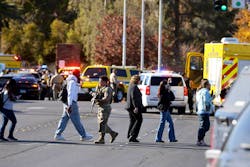As families and students work to heal from last week’s mass shooting at UNLV’s campus, public safety officials recently recounted what lessons were learned after the massacre at the Route 91 Harvest festival in Las Vegas.
Stephen Paddocks’ 10-minute shooting spree from his hotel room with high-powered rifles on Oct. 1, 2017, killed 60 people and injured hundreds more. It is still the deadliest mass shooting in modern U.S. history.
The UNLV shooter was 67-year-old Anthony James Pilito of Henderson, Nev. The victims were identified as Professor Jerry Cha-Jan Chang, and Assistant Professors Patricia Navarro Velez and Naoko Takemaru.
Paddock and Pilito appear to have a couple of similarities, as they were both older than the typical mass shooter age of 18-30 and were either emotionally or financially tied to the Las Vegas scene. The FBI’s report found no solid reasons for Paddock’s actions.
As for Pilito, investigators are still scrubbing social media, conducting interviews and piecing together other evidence. It’s been widely reported he’d been rejected for many teaching jobs in North Carolina and Nevada, including at UNLV. Students from Eastern Carolina University told The Los Angeles Times that Pilito was obsessed with Las Vegas and often made it a part of his lectures.
Officers did find on Pilito’s person a list of intended targets who all worked for universities. None of them became a victim during the incident, but it did possibly explain what grievances he had. Investigators are still combing through the other materials found in his home.
Making Adjustments
After the first 911 calls came in about shots fired at UNLV, Clark County Fire Chief John Steinbeck said in a news conference a rescue task force of police and firefighters were engaged in 10 minutes, where the “national average” is about 45 minutes.
“Before (on Oct. 1) we didn’t have ready-to-go plans that were in place for victim services. No community really does. The sheriff and I have gone across the nation teaching that you must have these resources ready to go. Last time, we were building them as we were responding.”
He also said the control of information is crucial and it necessitates having a joint information center during such incidents.
“There is so much information that comes across. At one point (at UNLV) I had the victim count way higher than what we ended up with,” Steinbeck said. “At the same time you’ve got information coming from those with phones, people on scene, people using conjecture. That information is necessary as we’re making operational decisions and recovery decisions.”
Clark County Sheriff Kevin McMahill said when he was on scene at UNLV he saw “seamless integration” by all law enforcement agencies, regardless of what department they worked for, which he attributes to utilizing the Las Vegas Metropolitan Police Department’s Reality-Based Training Center.
McMahill said the notification system UNLV utilized for students and faculty “was exceptional.”
The Next Step
Nonetheless, UNLV administrators have begun the process of reviewing the emergency platform and the number of security personnel assigned to each campus, said Adam Garcia, UNLV’s Vice President of Public Safety Services and Director of University Police Services Southern Command.
“Once we have gotten past this event, the intent is to bring a group on board to assist us in looking at this incident to see what we did right and what we can do to improve safety on campus,” Garcia said.
Garcia noted the first officer was on scene in 78 seconds and the quick response of law enforcement prevented a “bloodbath.”
There were rumors of students organizing a petition drive to make UNLV a closed campus. When asked his opinion of that, UNLV President Keith E. Whitfield said he would need to investigate whether such a move would be a deterrent to criminals.
“My inclination is to not close the campus, but there are other things we can do,” such as adding more cameras on campus, he said. “We have to be cautious that it doesn’t ultimately hurt what our ultimate purpose is -- to provide great education and opportunities for the citizens,” Whitfield said.
McMahill revealed last week there were no surveillance cameras inside Beam Hall where the shooting took place, which was making it harder for investigators to confirm the timeline of events during the shootings.
Whitfield did feel the Route 91 Harvest event did help educate faculty and students about “how to hide and be safe,” noting that officers found evidence of that as they worked to clear every building on the 332-acre campus.
McMahill said officers found groups of students huddling and hiding behind makeshift barricades and locked doors all over campus.
Training Every Day
Clearly the quick response saved lives. McMahill believes Polito was headed toward the Student Union next to Beam Hall, where students were having a barbeque and playing games.
“It’s a crime that we train for each and every day. When there is an active shooter threat, the southern Nevada first responder community responds quickly and decisively without hesitation,” he said. “Within minutes, on- and off-duty officers responded to prevent further loss of life.
“If it hadn’t been for the heroic actions of one of those police officers who responded, there could have been countless additional lives taken.”
The incident began when a citizen reported shots fired on the UNLV campus. Through subsequent 911 calls police determined the shooter was at Beam Hall, next to the Student Union.
Authorities said Polito arrived on campus at 11:28 p.m. in an older model Lexus. He brought a Taurus 9mm handgun and 11 magazines with him, nine of which were found loaded and on his person. The gun had been purchased legally in 2022.
LVMPD and UNLV officers arrived and were able to identify gunfire coming from Beam Hall and immediately made entry.
Pilito was seen exiting near the main entrance of the building at about 11:55 a.m., where he was confronted by UNLV plain-clothed officers and a gunfight ensued. Pilito was struck multiple times and died at the scene.
A systematic search of Beam Hall located two victims on the third floor and one victim was on the fourth floor. Another scene was located on the fifth floor where it is believed a fourth victim, a visiting professor, had been shot.
He made it to the ground floor before being taken to a hospital.
Polito’s vehicle was located on school property equipped with a dashcam.
After securing a search warrant, detectives were able to view the footage and discovered he had stopped at a Henderson post office. Polito dropped off 22 pieces of mail to various university personnel across the country with no return address.
Authorities combed through 14,000 pieces of mail to find the envelopers Polito mailed. The contents of the envelopes are still being evaluated.
A search warrant for Polito’s residence was conducted and police found documents like a last will and testament, along with several computer and hard drive components and ammunition consistent with the cartridge casings located on scene.
Finding a Middle Ground
Chris Grollnek, a longtime active shooter expert who founded the Active Shooter Prevention Project, said he considered the response on scene to be “amazing.”
He didn’t know if the university had any technology to detect weapons coming onto the campus, but UNLV did have a mass notification system.
Grollnek said many universities have and continue to be standoffish with new technologies such gun detection, as they are worried about establishing a “surveillance state.” He noted many of the surveillance technologies that concern higher education administrators and board members are already in widespread use in other venues.
“There is an information and understanding gap. It’s a moot argument,” he said.
Grollnek doesn’t feel “Run-Hide-Fight” is the ultimate answer, as it does nothing to stop the shooting. The directive also has many nuances, he notes, such as its practicality for special needs students.
“We have to find a middle ground, which is technology,” he said.
He does feel first-responder training as come a long way, especially after the Sandy Hook tragedy in Massachusetts became a catalyst for a national standard for alerts, training, formations, weapons, people and equipment used in response.
“And what we found from 2012 to 2022 in Uvalde,” he said, “is you might have an officer trained to a standard, but not trained to achievement level. You can pass a test and drills, but when shots are fired you don’t know how someone will react. We’re all human.”
John Dobberstein is managing editor of SecurityInfoWatch.com and oversees all content creation for the website. Dobberstein continues a 34-year decorated journalism career that has included stops at a variety of newspapers and B2B magazines.
About the Author
John Dobberstein
Managing Editor/SecurityInfoWatch.com
John Dobberstein is managing editor of SecurityInfoWatch.com and oversees all content creation for the website. Dobberstein continues a 34-year decorated journalism career that has included stops at a variety of newspapers and B2B magazines. He most recently served as senior editor for the Endeavor Business Media magazine Utility Products.

